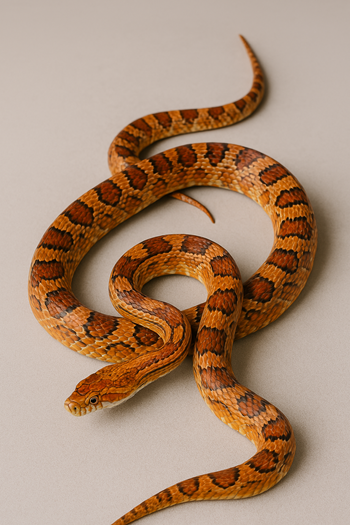There is no greater thrill then finally deciding to take the plunge and purchase your first reptile or amphibian. Hopefully you will not take this task lightly since the species of reptile or amphibian you choose and the specific animal you pick out from the pet store can greatly affect your first experience.

Beware that not all these animals are suitable for the beginner. For example, some lizards such as monitors, and iguanas are best left to experienced keepers as they require very specific setups and handling.
Snakes
Many snakes make excellent first pets. Almost any member of the colubrid family is a good choice for the beginner reptile keeper. I would specifically recommend either a corn snake or a milk snake. Both snakes come in a variety of color morphs, both have a good temperament and can be handled often. Another snake with a great temperament that can make a good pet is the ball python. While we generally don’t recommend many boas or pythons for the beginning reptile keeper, the ball python stays relatively small (usually around four feet or less) and has a great temperament. While something like a boa constrictor or Burmese python can look tempting, they do get quite large and require a large amount of space and adult boa constrictors or Burmese pythons should only be handled by experienced keepers.
Lizards
Too many people think that an anole or an iguana would be a good first reptile pet because of their inexpensive price tag and small size. What most people don’t realize that the green anole will require the same expensive setup as many other larger lizards. In the case of the iguana, not only does it require an expensive setup, they will also reach up to six feet in length and can become aggressive as adults. If you are in the market for a small lizard, then the leopard gecko is an ideal lizard to start with. Leopard geckos have a great personality and because they are nocturnal, you do not have to worry about setting up specialized lighting for their enclosure. They tolerate being handled very well and there are now many different color morphs available. If you would prefer a slightly larger lizard, then consider the bearded dragon. They don’t get as large as an iguana and tend to have much better temperaments. The setup is a bit more advanced than for a leopard gecko, but it is not overly difficult.
Turtles
Many species of aquatic turtles are a more difficult to care for because you also need to worry about the water quality. Also, many aquatic turtles require more space than most people realize. Tortoises are great because you do not need to worry about an aquatic habitat. The problem is that many tortoises like the sulcata, also called the African spurred tortoise, can get quite large. A great tortoise to start with is the Russian tortoise. They stay a reasonable size at less than a foot in length and have a great personality. If you’re up for the challenge of owning a tortoise, then these guys are a perfect choice to start with.
Amphibians
These make for great display animals, but most amphibians cannot be held or touched. For people who are looking for a pet that they can handle, choosing one of the reptile species listed above is probably a better idea. One of the easiest species of frog to take care of is the South American horned frog, also called the Pacman frog. They are easy to maintain and are also eating machines that can be great fun to watch. If you have had experience with tropical fish tanks, then making a jump to newts like fire belly newt or the rough-skinned newt can make for an easy transition to keeping amphibians. These newts do very well at room temperature and if you have the proper filtration in your aquarium, they will thrive for you. Many people have as much fun setting up the aquarium for a natural habitat as they do watching the newts. With a little practice you can set up beautiful habitats for your newts that you’ll love to show off to your friends and family.
No matter what species you decide to get for your first reptile or amphibian pet, make sure to research it before you bring it home. You should know how big it will get, what it eats, and what kind of enclosure you need before it ever comes home with you. The most common reason that pet reptiles or amphibians die prematurely is because that the owners do not understand how to properly take care of their pet. Many pet reptiles and amphibians are given up for adoption or surrendered because people did not realize what they were getting themselves into when they purchase them. By doing your research you can avoid choosing a pet that does not fit your lifestyle.
Background for this article was provided by the Western New York Herpetological Society
Related Articles & Free Email Newsletter Sign Up
Are Your Fish Swimming Upside Down? How to Solve a Swim Bladder Problem
Everything You Need to Know About Turtles


Comment here